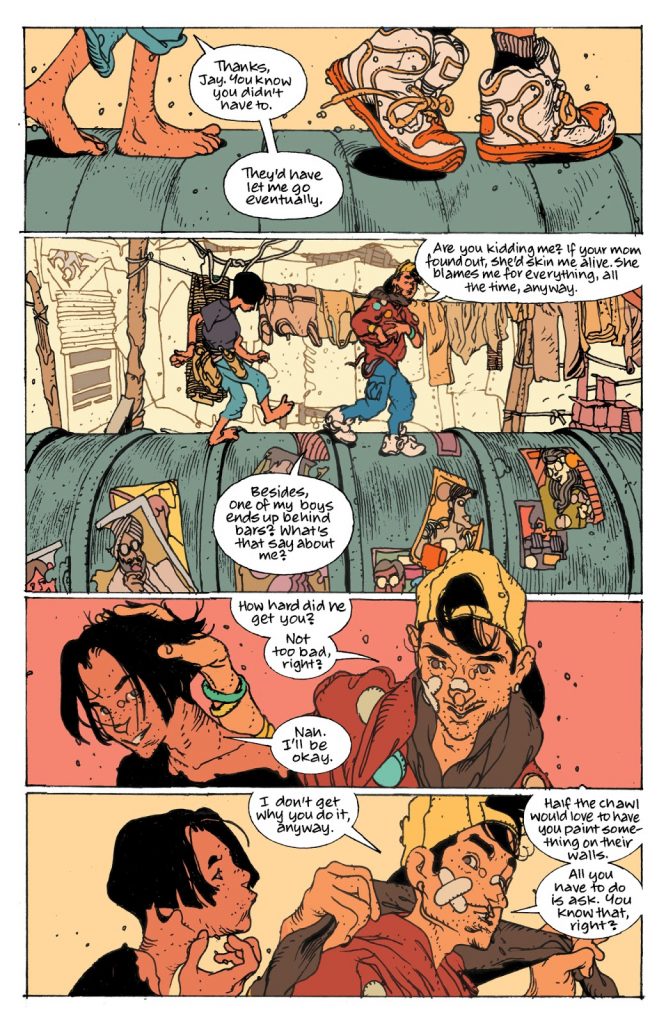The Power in Place
On Ram V, psychogeography, and how location can change everything for a good comic.
Places are alive, they breathe and grow, they wither and die. The places we inhabit are a transient, constantly changing background brought to life by our stories. A city’s architecture and shape shifts with shifting people. You may want to preserve a place, but “ultimately it’s all gonna go,” so says Alan Moore talking about his novel Jerusalem, which is about the town of Northampton, where he has lived his whole life. He says capturing places in fiction is “the only way that you can save it. Not in the sense of rescu[ing] it, but you can save it like a ship in a bottle, which I think is one of the functions of art.”
But that misses a contextual element. Alan Moore’s Northampton is different to my Northampton. I grew up just outside Northampton and moved away to Liverpool, and the Northampton that Moore sees as needing saving is a different place to the Northampton that I knew when I lived nearby. Can you really preserve the whole of something that means vastly different things to different people? My reading of Jerusalem will be different to Moore’s, and will be different to someone with no relationship to Northampton. Perhaps it’s less preservation so much as it is translation.
This is something I spoke about with Ram V, writer of DC’s Catwoman and Swamp Thing, as well as gorgeous graphic novels like Grafity’s Wall and Blue in Green (both with artist Anand RK and letterer Aditya Bidikar) and creator-owned series including These Savage Shores and Paradiso. He’s lived and traveled all around the world, growing up in Mumbai before moving to the US and then the UK. His stories often lean into a focus on places and he challenges the idea of merely preserving places with storytelling, saying “If you’re going to use a place as an important participant in your story, I can’t imagine writing a story where the place doesn’t change,” adding “if it doesn’t change, it’s just furniture.”
While creating work with a palpable sense of place could have a certain preservative quality, freezing a living, moving city, Ram points out that change is at the heart of both stories and places. Preserving means stagnation. Ram’s coming-of-age tale Grafity’s Wall is perhaps the most potent depiction of a place in his work. Here, Mumbai is condensed into 120 pages of unmoving sequential images that maintain the tumultuous, unset nature of the city. The book, once written, illustrated, coloured, and lettered, cannot change.
But it is not static. There is life and change in the movement through it. It is alive in the reading. Ram describes stories to me as “not really communication; they’re an expression of an artist’s, or a writer’s, perspective, but as a reader that fiction is translated to resonate with your experiences.” The story changes when translated to your circumstances. In comics, the change between panels happens in the blank space of the gutter, the reader has to do the work to see the movement. The events of the story exist as a collaboration between the book and your mind. The static images moving through you.

This collaboration mirrors the creation of any of Ram’s comics works, which are not just his comics, but also his artistic collaborators. For Anand RK and Aditya Bidikar, who live in or relatively near Mumbai respectively, that city is a closer reality than it is for Ram, who only visits to see family. Ram tells me that “everyone sees it a little differently. That’s the joy of collaborating with someone.” Grafity’s Wall becomes a conversation between Ram’s remembered Mumbai, and RK and Bidikar’s currently immersed experience of it.
Even within that, each of their experiences are not monolithic. Ram brings up how experiences of class stratification in the city changed during his own life, explaining, “when I was a kid, we were quite poor, but then my father became very successful and we were well-to-do by the time I left Mumbai. I’ve had that translation of experience, where I’ve seen both the poverty in Mumbai and what it’s like when you’re well-to-do. And Anand has had his separate experience of that, Aditya has had his separate experience of that. I think that kind of cross-class, cross-cultural experience of a place becomes very interesting when you collaborate to make a comic.”
subscribers only.
Learn more about what you get with a subscription
